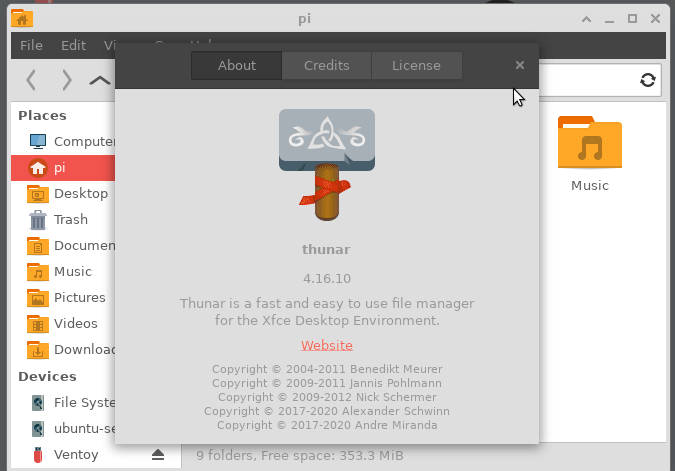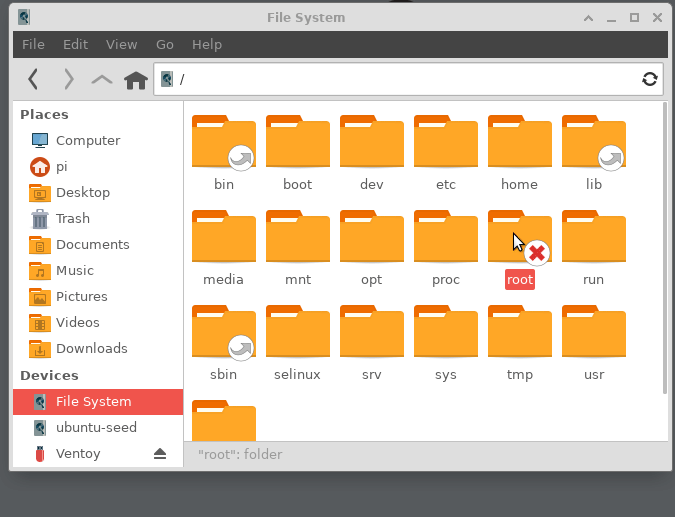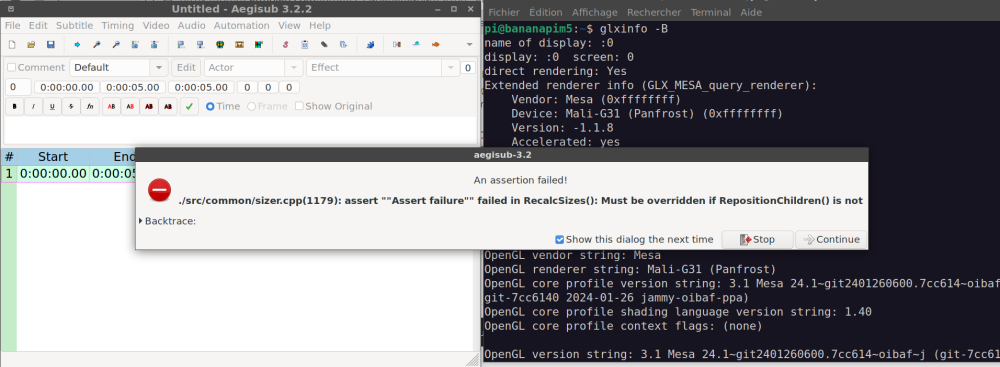-
Posts
46 -
Joined
-
Last visited
Recent Profile Visitors
970 profile views
-
Hello, Well, ladies and gentlemen, I done it, becoz I can't live without it when quitting cinnamon for xfce. It is like the thunar-archive-plugin (file-roller equivalent) that should be enabled by default imho. I decided to release it here , this is my gift to armbian team to thanks for their work. INSTALLATION If you follow the README.md, you will have the magic custom action added The demo: Enjoy SoSie thunar-open-as-root-plugin.zip
-

About making really hardware accelleration working with videos with aegisub
SoSie replied to SoSie's topic in Banana Pi M5
I tried with recommanded lxc (linux container is more secure) but opengl Mai is not recognized ----> so instead of sudo mkdir -p /srv/chroot/armbian sudo debootstrap --arch arm64 --foreign bookworm /srv/chroot/debian-arm64 http://debian.xtdv.net/debian sudo schroot -c debian-arm64 (step to create user pi skipped) apt install aegisub inxi We notice EVERYTHING IS RECOGNIZED: (debian-arm64)root@bananapim5:/home/pi# inxi -Gs Graphics: Device-1: meson-g12a-vpu driver: meson_drm v: N/A Device-2: meson-g12a-mali driver: panfrost v: kernel Device-3: meson-g12a-dw-hdmi driver: meson_dw_hdmi v: N/A Display: server: X.Org v: 1.21.1.4 driver: dri: meson gpu: meson_drm,panfrost,meson_dw_hdmi note: X driver n/a resolution: 1920x1080~60Hz API: OpenGL v: 3.1 Mesa 22.3.6 renderer: Mali-G31 (Panfrost) Sensors: System Temperatures: cpu: 44.3 C mobo: N/A Fan Speeds (RPM): N/A ++++++> I have done sudo lxc-create --name "arm64-bookworm" --template download -- --dist debian --release bookworm --arch arm64 sudo lxc-start -n "arm64-bookworm" sudo lxc-attach -n "arm64-bookworm" apt install aegisub inxi We notice GL is not FULLY DETECTED root@arm64-bookworm:/home/pi# inxi -Gs Graphics: Device-1: meson-g12a-vpu driver: meson_drm v: N/A Device-2: meson-g12a-mali driver: panfrost v: kernel Device-3: meson-g12a-dw-hdmi driver: meson_dw_hdmi v: N/A Display: server: X.org v: 1.21.1.7 driver: X: loaded: fbdev,modesetting gpu: mroot@arm64-bookworm:/home/pi# inxi -Gs Graphics: Device-1: meson-g12a-vpu driver: meson_drm v: N/A Device-2: meson-g12a-mali driver: panfrost v: kernel Device-3: meson-g12a-dw-hdmi driver: meson_dw_hdmi v: N/A Display: server: X.org v: 1.21.1.7 driver: X: loaded: fbdev,modesetting gpu: meson_drm,panfrost,meson_dw_hdmi resolution: 1920x1080 API: OpenGL Message: GL data unavailable for root. eson_drm,panfrost,meson_dw_hdmi resolution: 1920x1080 API: OpenGL Message: GL data unavailable for root. root@arm64-bookworm:/home/pi# lshw -c video *-graphics product: mesondrmfb physical id: 5 logical name: /dev/fb0 capabilities: fb configuration: depth=32 resolution=720,480 root@arm64-bookworm:/home/pi# xrandr --listproviders Can't open display :0 The reason is OpenGL rely on Xorg and Xorg can't find my display event after doing export DISPLAY=:0 the device :dev/fb0 does not exist also.as we can seet it withe the Xorg log: root@arm64-bookworm:/home/pi# cat /var/log/Xorg.0.log [ 25980.096] X.Org X Server 1.21.1.7 X Protocol Version 11, Revision 0 [ 25980.096] Current Operating System: Linux arm64-bookworm 6.2.0-rc3-meson64 #23.02.2 SMP PREEMPT Fri Feb 17 23:06:22 UTC 2023 aarch64 [ 25980.096] Kernel command line: root=UUID=4cc9d1be-c592-4e80-8f1c-e73b8c044930 rootwait rootfstype=ext4 splash plymouth.ignore-serial-consoles console=ttyAML0,115200 console=tty1 consoleblank=0 coherent_pool=2M loglevel=1 ubootpart=7ac72bfa-01 libata.force=noncq usb-storage.quirks=0x2537:0x1066:u,0x2537:0x1068:u,0x1058:0x1001:u video=drm_kms_helper.edid_firmware=HDMI-A-1:edid/720x480.bin video=HDMI-A-1:720x480M@60 fbcon=rotate:0 module_blacklist=simpledrm cgroup_enable=memory swapaccount=1 [ 25980.096] xorg-server 2:21.1.7-3+deb12u5 (https://www.debian.org/support) [ 25980.096] Current version of pixman: 0.42.2 [ 25980.097] Before reporting problems, check http://wiki.x.org to make sure that you have the latest version. [ 25980.097] Markers: (--) probed, (**) from config file, (==) default setting, (++) from command line, (!!) notice, (II) informational, (WW) warning, (EE) error, (NI) not implemented, (??) unknown. [ 25980.097] (==) Log file: "/var/log/Xorg.0.log", Time: Sun Mar 17 20:03:34 2024 [ 25980.098] (==) Using config directory: "/etc/X11/xorg.conf.d" [ 25980.098] (==) Using system config directory "/usr/share/X11/xorg.conf.d" [ 25980.100] (==) ServerLayout "dummy_layout" [ 25980.100] (**) |-->Screen "dummy_screen" (0) [ 25980.100] (**) | |-->Monitor "dummy_monitor" [ 25980.101] (**) | |-->Device "dummy_videocard" [ 25980.101] (**) |-->Input Device "dummy_mouse" [ 25980.101] (**) |-->Input Device "dummy_keyboard" [ 25980.101] (==) Automatically adding devices [ 25980.101] (==) Automatically enabling devices [ 25980.101] (==) Automatically adding GPU devices [ 25980.101] (==) Automatically binding GPU devices [ 25980.101] (==) Max clients allowed: 256, resource mask: 0x1fffff [ 25980.101] (WW) The directory "/usr/share/fonts/X11/cyrillic" does not exist. [ 25980.101] Entry deleted from font path. [ 25980.101] (==) FontPath set to: /usr/share/fonts/X11/misc, /usr/share/fonts/X11/100dpi/:unscaled, /usr/share/fonts/X11/75dpi/:unscaled, /usr/share/fonts/X11/Type1, /usr/share/fonts/X11/100dpi, /usr/share/fonts/X11/75dpi, built-ins [ 25980.101] (==) ModulePath set to "/usr/lib/xorg/modules" [ 25980.101] (II) Loader magic: 0xaaaac1da0f00 [ 25980.101] (II) Module ABI versions: [ 25980.101] X.Org ANSI C Emulation: 0.4 [ 25980.101] X.Org Video Driver: 25.2 [ 25980.101] X.Org XInput driver : 24.4 [ 25980.101] X.Org Server Extension : 10.0 [ 25980.105] (EE) systemd-logind: failed to get session: PID 991 does not belong to any known session [ 25980.109] (II) xfree86: Adding drm device (/dev/dri/card0) [ 25980.109] (II) Platform probe for /sys/devices/platform/soc/ff900000.vpu/drm/card0 [ 25980.111] (II) xfree86: Adding drm device (/dev/dri/card1) [ 25980.111] (II) Platform probe for /sys/devices/platform/soc/ffe40000.gpu/drm/card1 [ 25980.111] (II) no primary bus or device found [ 25980.111] (II) LoadModule: "glx" [ 25980.112] (II) Loading /usr/lib/xorg/modules/extensions/libglx.so [ 25980.115] (II) Module glx: vendor="X.Org Foundation" [ 25980.116] compiled for 1.21.1.7, module version = 1.0.0 [ 25980.116] ABI class: X.Org Server Extension, version 10.0 [ 25980.116] (==) Matched modesetting as autoconfigured driver 0 [ 25980.116] (==) Matched fbdev as autoconfigured driver 1 [ 25980.116] (==) Assigned the driver to the xf86ConfigLayout [ 25980.116] (II) LoadModule: "modesetting" [ 25980.116] (II) Loading /usr/lib/xorg/modules/drivers/modesetting_drv.so [ 25980.117] (II) Module modesetting: vendor="X.Org Foundation" [ 25980.117] compiled for 1.21.1.7, module version = 1.21.1 [ 25980.117] Module class: X.Org Video Driver [ 25980.117] ABI class: X.Org Video Driver, version 25.2 [ 25980.117] (II) LoadModule: "fbdev" [ 25980.117] (II) Loading /usr/lib/xorg/modules/drivers/fbdev_drv.so [ 25980.117] (II) Module fbdev: vendor="X.Org Foundation" [ 25980.118] compiled for 1.21.1.3, module version = 0.5.0 [ 25980.118] Module class: X.Org Video Driver [ 25980.118] ABI class: X.Org Video Driver, version 25.2 [ 25980.118] (II) LoadModule: "void" [ 25980.118] (WW) Warning, couldn't open module void [ 25980.118] (EE) Failed to load module "void" (module does not exist, 0) [ 25980.118] (II) modesetting: Driver for Modesetting Kernel Drivers: kms [ 25980.118] (II) FBDEV: driver for framebuffer: fbdev [ 25980.119] (WW) Falling back to old probe method for modesetting [ 25980.119] (EE) open /dev/dri/card0: No such file or directory [ 25980.119] (WW) Falling back to old probe method for fbdev [ 25980.119] (II) Loading sub module "fbdevhw" [ 25980.119] (II) LoadModule: "fbdevhw" [ 25980.119] (II) Loading /usr/lib/xorg/modules/libfbdevhw.so [ 25980.119] (II) Module fbdevhw: vendor="X.Org Foundation" [ 25980.119] compiled for 1.21.1.7, module version = 0.0.2 [ 25980.119] ABI class: X.Org Video Driver, version 25.2 [ 25980.120] (EE) open /dev/fb0: No such file or directory [ 25980.120] (WW) Falling back to old probe method for modesetting [ 25980.120] (EE) open /dev/dri/card0: No such file or directory [ 25980.120] (WW) Falling back to old probe method for fbdev [ 25980.120] (II) Loading sub module "fbdevhw" [ 25980.120] (II) LoadModule: "fbdevhw" [ 25980.120] (II) Loading /usr/lib/xorg/modules/libfbdevhw.so [ 25980.120] (II) Module fbdevhw: vendor="X.Org Foundation" [ 25980.120] compiled for 1.21.1.7, module version = 0.0.2 [ 25980.120] ABI class: X.Org Video Driver, version 25.2 [ 25980.120] (EE) open /dev/fb0: No such file or directory [ 25980.120] (EE) No devices detected. [ 25980.120] (EE) Fatal server error: [ 25980.120] (EE) no screens found(EE) [ 25980.120] (EE) Please consult the The X.Org Foundation support at http://wiki.x.org for help. [ 25980.121] (EE) Please also check the log file at "/var/log/Xorg.0.log" for additional information. [ 25980.121] (EE) [ 25980.121] (EE) Server terminated with error (1). Closing log file. Thus starting aegisub in linux container is impossible. root@arm64-bookworm:/home/pi# su - pi pi@arm64-bookworm:~$ aegisub-3.2 12:56:43: Error: Unable to initialize GTK+, is DISPLAY set properly? So now the question is DOES SOMEONE KNOW HOW TO MAKE LINUX CONTAINER WORK GRAPHICALLY UNDER Ubuntu JAMMY? -
Hello all, As subtitler guy, I experienced many troubles making aegisub work. , I finally made the subtitle editor, working with hardware under armbian jammy but having still annoyances. I want to share my thought and my discoveries on it. First I would like to thanks all who post on this already, including alternative ways such as schroot and of course the armbian team for the improvements of the boot .. schroot allow to run an linux in a linux. According to what I experienced, meson driver development is leaded by oibaf and in advance in ubuntu but here aegisub does exists only on debian. The idea was thus to boot on debian jammy and chroot in debian buster armhf at least or better bookworm arm64. By doing so, I crashed many time aegisub 3.2.2 due to lua badly supported. schrooting and debian bookworm gives many warning messages (see the pict below, I washed the lua script directory too) but goes further if we dare to skip assert warnings. Moreover, at this point, we are no more dealing with Llvm (software accel using 100% of CPUs) but meson-drm and panfrost (harware accel, using 20% of CPUs). aegisub still remains very fragile but very responsive. So today I decided to switch and to boot into bookworm directly. After launching aegisub 3.20.3 on arm64 with panfrost enabled (you can check this with glxinfo -B, or inxi -Gs), I discovered it is very stable but suffered of responsivity due to a flood in the logs Hewitt has just given... a patch yesterday against "panfrost ffe40000.gpu: l2 power transition timeout" log flood here: https://lkml.org/lkml/2024/3/22/977 You will also be unable to set brightness by software (too bright for my eyes) at least on xfce4, trying my luck with all techniques https://askubuntu.com/questions/894465/changing-the-screen-brightness-of-the-external-screen that did not succeed except that ddcci-dkms gave me a clue during install : BACKLIGHT_CLASS_DEVICE disabled in this kernel I suggest enabling dkms and this for future kernel and taking Hewitt patch into account. With these findings, did someone has noticed the same and manage to make sound and videos responsive without unsync? PS/ For now, the armbian is on a sdcard, the log flood may be the cause of the unsync. I have to test further. Trying with latest jammy and schrooting under bookworm.
-
GOOD NEWS FOLKS !!! I can say now UEFI x86 can arm64 chroot in Armbian if we fix the missing link as I indicated in https://armbian.atlassian.net/browse/AR-1820 thus we can, i imagine, cross compile in the target sbc directly. Here is the screenshot..
-
Hello All, I spent mainly a week figuring out why it was a nightmare with cinnamon on debian I thought it was a matter of cinnamon version and/or mesa version of panfrost but it was a modeline detection problem from xorg. After trying my luck I finally discover where the bad duck resided on debian versions : - bullseye who was lagging , managing to use mali accel but overflowded with log errors - bookworm was loosing HDMI signal just after login in.. I will only talk about bookworm In fact, cinnamon internal xrandr, tool who detect the screen modelines, fails to access and to grab screen EDID modelines like xrandr did. it results it acts like it was in headless mode. Taking this into account I reinstalled the xorg-dummy-video pacakge and my /etc/X11/xorg.conf.d/01-armbian_defaults.conf l provided in then it succeed to login in low res. 720x480 declared in /boot/armbianEnv.txt. Fromcinnamon it is impossible to change the resolution display, the display tool did not react in cinnamon-settings, it crashes. I have to use the alternate arandr. to change the screen resolution on each reboot
-
Hello, I managed to boot recently on external usb sata. here is the HOW-TO I would have seen somewhere.. I - Install armbian x86 UEFI I really recommend it ! You will be able to compile arm from it faster. just before going on, it possible to put it side by side with LMDE5 and share /home using garted copy and paste of partitions! II - Install armbian arm64 aside and outside 😎 1) I used gparted to make free space and create a new partition of size 14749 Mb (size of emmc) /dev/sdaX 2) then decompress the image you downloaded from (redirect).armbian.com big KISS to @Werner for the mirror ! here <foo> is for example jammy,bullseye,bookworm etc.. unxz -T0 Armbian_<version>_<foo>_arm64.img.tz 3) copy it to the partition (and SD) a) then you mount armbian_<version>_<foo>_arm64.img with gnome-disks utility or other way b) inside gnome-disk locate THE ARMBIAN_ROOT PARTITION and mount it. click on the link /media/$USER/armbian_root c) The fastest way to transfer I found is with partclone (see ubuntu manual that indicates partiitons should be umounted!): partclone.extfs -b -d -s /media/$USER/armbian_root -o /dev/sdaX 4) Fix the UUID if it does not match you can access to the /boot directory , in this directory you see the UUID in the boot/armbianEnv.txt like "SoSIe-Love-Armbian-It-R0cks" or in etc/fstab you use tune2fs to set the partition /dev/sdaX to it with: tune2fs /dev/sdaX -U <UUID> 5) then you copy it to a sdcard > 16Go to boot on it dd if=/dev/sdaX of=/dev/<sdcard> bs=10M 6) Put the sdcard on the sbc bananapiM5 and boot it recommend to install to emmc with armbian-install or dd way like i discribed before , then shutdown the sbc, remove the sdcard, light on to make all actions in the emmc because it is faster and safer 7 ) Now inside as root you can copy boot as boot-emmc mkdir /boot-emmc rsync -aPz /boot /boot-emmc 8 ) then you rename boot mv boot boot-usb-sata-<foo> 9) Adapt armbianEnv.txt and boot.cmd tfor usb sata target cd /boot-usb-sata-<foo> Check the armbianEnv.txt and boot.cmd to match target usb sata partition drive a) the UUID must match those of /dev/sdaX (or other armbian_root) b) rootdevfs is no more /dev/mmcblk1p1 but /dev/sdaX (or other armbian_root) 10) then you do symlink to usb sata boot, the one you want to boot rm boot # erase previous link, ln -sf does nothing ln -s boot-usb-sata-<foo> boot 11) Ensure your usb sata drive is connected to BPI M5 usb3 port.. I have a powered usb sata case. I notice the power is not enougth on USB3 to handle usb sata drive 11) Reboot the baby.. now you should boot on usb sata /dev/sdaX ! of course ONE WILL SAY, HEY DUDE, THERE IS THE ARMBIAN-INSTALL SCRIPT...yes but no it can not handle side by side boot without erasing all drive.
-
Hi Monk, rootfstype=f2fs , I did not heard about f2 filesystem, should'nt be ext4 instead ?
-

Making Libreelec work on Bananapi M5 side by side with Armbian possible?
SoSie replied to SoSie's topic in Banana Pi M5
@Chewitt, thanks for taking time to try and reply; the image boots correctly on KERNEL - I think the log you provided stop at this step - but when it passes the hand to the SYSTEM image it fails. SYSTEM fails to be mounted because of the missing link in /flash leaving the user lost in space in initramfs level but when you restore the missing link in the SYSTEM image like I did , it works and I see LE logo and are able to use Kodi LE. In LE, infrared remote is better handled and we have Mali G-31 accel working ( this is on way to be solved in armbian (I enjoyed the constructive exchanges with the Armbian team busy but available here https://github.com/armbian/build/pull/5004 ) but I had video codec playing issues - it is a common mesa versioning nightmare on M5 - I got squared green video when I trigger some as if video was encrypted which is not the case as I can play without problem in Kodi Debian 19.4. All this bring me, the idea that it will be good to gather Kodi Debian and Kodi LE experiences to avoid regressions and redundant efforts at least on mesa, to determine which version works and reliable. I should build also a mesamonitor for LE as I did here https://armbian.atlassian.net/browse/AR-1641 based on kodi logs. -

Making Libreelec work on Bananapi M5 side by side with Armbian possible?
SoSie replied to SoSie's topic in Banana Pi M5
Better script: previous was buggy wget https://ftp.halifax.rwth-aachen.de/libreelec/LibreELEC-AMLGX.arm-11.0.1-bananapi-m5.img.gz gunzip LibreELEC-AMLGX.arm-11.0.1-bananapi-m5.img.gz sudo su - partx -a LibreELEC-AMLGX.arm-11.0.1-bananapi-m5.img #this next command should give loop0p1=LIBREELEC , loop0p2=STORAGE (empty, resized with missing config created during install) losetup -a /dev/loop0 if [ ! -d "/media/LIBREELEC" ]; then mkdir /media/LIBREELEC; fi mount /dev/loop0p1 /media/LIBREELEC cp /media/LIBREELEC/SYSTEM . unsquashfs SYSTEM cd squashfs-root/flash #here is the missing killing link ln -s .. SYSTEM cd - mksquashfs squashfs-root/ SYSTEM -noappend -comp zstd -Xcompression-level 15 cp SYSTEM /media/LIBREELEC/ umount /dev/loop0p1 losetup -d /dev/loop0 -

Making Libreelec work on Bananapi M5 side by side with Armbian possible?
SoSie replied to SoSie's topic in Banana Pi M5
Okay I filled an issue on Github. -
Hello, I know this is a forbidden question, I will adress specially to @chewitt and @Igor. Why I dare to do this? Because today, it is the fist time I managed to run Libreelec (LE) nighly https://test.libreelec.tv/11.0/Amlogic/bananapi-m5/ and have the somehow the same suffering with boot and so on and as I did not give up, I shot the last bug preventing LE to boot. I don't want to register in every forum for each pack , christian forgive me I will put the explanation here. The last image suffer from a missing link..in /flash as it is all momified in squashfs , this need extra skills. wget https://ftp.halifax.rwth-aachen.de/libreelec/LibreELEC-AMLGX.arm-11.0.1-bananapi-m5.img.gz gunzip LibreELEC-AMLGX.arm-11.0.1-bananapi-m5.img partx -a LibreELEC-AMLGX.arm-11.0.1-bananapi-m5.img losetup -a /dev/loop0 mount /dev/loop0p1 /media/LIBREELEC cp /media/LIBREELEC/SYSTEM . unsquashfs SYSTEM cd squashfs-root/flash #here is the missing killing link ln -s .. SYSTEM cd - mksquashfs squashfs-root/ -noappend -comp zstd -Xcompression-level 15 cp SYSTEM /media/LIBREELEC/ umount /dev/loop0p1 Then use gparted to wipe out the sdcard, and use dd dd if=LibreELEC-AMLGX.arm-11.0.1-bananapi-m5.img of=/dev/mmcblck1 bs=1M Boot and ENJOY!
-
@Badger , have you tried to launch your script as autostart app?
-
I tested with kernel 5.19.16, @Igor solution does not work maybe for kernels >= 6. [EDIT tried with 6.11 it gives low resolution 720 X 576. You need extra xorg config file like below, for now Impossible to make glamouregl / panfrost Mali G31recognized like in 5.19.16 pi@bananapim5:/usr/lib/aarch64-linux-gnu/dri$ glxinfo -B name of display: :0 display: :0 screen: 0 direct rendering: Yes Extended renderer info (GLX_MESA_query_renderer): Vendor: Mesa (0xffffffff) Device: Mali-G31 (Panfrost) (0xffffffff) Version: 23.1.0 Accelerated: yes Video memory: 3785MB Unified memory: yes Preferred profile: core (0x1) Max core profile version: 3.1 Max compat profile version: 3.1 Max GLES1 profile version: 1.1 Max GLES[23] profile version: 3.1 OpenGL vendor string: Mesa OpenGL renderer string: Mali-G31 (Panfrost) OpenGL core profile version string: 3.1 Mesa 23.1.0-devel (git-60ae5b1 2023-03-04 jammy-oibaf-ppa) OpenGL core profile shading language version string: 1.40 OpenGL core profile context flags: (none) OpenGL version string: 3.1 Mesa 23.1.0-devel (git-60ae5b1 2023-03-04 jammy-oibaf-ppa) OpenGL shading language version string: 1.40 OpenGL context flags: (none) OpenGL ES profile version string: OpenGL ES 3.1 Mesa 23.1.0-devel (git-60ae5b1 2023-03-04 jammy-oibaf-ppa) OpenGL ES profile shading language version string: OpenGL ES GLSL ES 3.10 ], Dummy driver solution works remotely but sometimes did not show the desktop (black screen with blinking cursor at first line) if an HDMI monitor is connected depending on kernel or xorg I assume! and without hardware acceleration. I converged to this completing the /etc/X11/xorg.conf.d/01-armbian_defaults.conf # This xorg configuration file is meant to be used by xpra # to start a dummy X11 server. # For details, please see: # https://xpra.org/Xdummy.html Section "ServerFlags" #Option "DontVTSwitch" "true" #Option "AllowMouseOpenFail" "true" Option "PciForceNone" "true" #Option "AutoEnableDevices" "false" #Option "AutoAddDevices" "false" EndSection Section "InputDevice" Identifier "dummy_mouse" Option "CorePointer" "true" Driver "void" EndSection Section "InputDevice" Identifier "dummy_keyboard" Option "CoreKeyboard" "true" Driver "void" EndSection Section "Device" Identifier "dummy_videocard" #If you uncomment you will have llvmpipe (LLVM 15.0.6, 128 bits), loosing hardware accel Mali G-31 (panfrost). #Driver "dummy" Option "ConstantDPI" "true" #VideoRam 4096000 #VideoRam 256000 VideoRam 192000 EndSection Section "Monitor" Identifier "dummy_monitor" HorizSync 5.0 - 1000.0 VertRefresh 5.0 - 200.0 #This can be used to get a specific DPI, but only for the default resolution: #DisplaySize 508 317 #NOTE: the highest modes will not work without increasing the VideoRam # for the dummy video card. #Modeline "32768x32768" 15226.50 32768 35800 39488 46208 32768 32771 32781 32953 #Modeline "32768x16384" 7516.25 32768 35544 39192 45616 16384 16387 16397 16478 #Modeline "16384x8192" 2101.93 16384 16416 24400 24432 8192 8390 8403 8602 Modeline "8192x4096" 424.46 8192 8224 9832 9864 4096 4195 4202 4301 Modeline "5496x1200" 199.13 5496 5528 6280 6312 1200 1228 1233 1261 Modeline "5280x1080" 169.96 5280 5312 5952 5984 1080 1105 1110 1135 Modeline "5280x1200" 191.40 5280 5312 6032 6064 1200 1228 1233 1261 Modeline "5120x3200" 199.75 5120 5152 5904 5936 3200 3277 3283 3361 Modeline "4800x1200" 64.42 4800 4832 5072 5104 1200 1229 1231 1261 Modeline "3840x2880" 133.43 3840 3872 4376 4408 2880 2950 2955 3025 Modeline "3840x2560" 116.93 3840 3872 4312 4344 2560 2622 2627 2689 Modeline "3840x2048" 91.45 3840 3872 4216 4248 2048 2097 2101 2151 Modeline "3840x1080" 100.38 3840 3848 4216 4592 1080 1081 1084 1093 Modeline "3600x1200" 106.06 3600 3632 3984 4368 1200 1201 1204 1214 Modeline "3288x1080" 39.76 3288 3320 3464 3496 1080 1106 1108 1135 Modeline "2048x2048" 49.47 2048 2080 2264 2296 2048 2097 2101 2151 Modeline "2048x1536" 80.06 2048 2104 2312 2576 1536 1537 1540 1554 Modeline "2560x1600" 47.12 2560 2592 2768 2800 1600 1639 1642 1681 Modeline "2560x1440" 42.12 2560 2592 2752 2784 1440 1475 1478 1513 Modeline "1920x1440" 69.47 1920 1960 2152 2384 1440 1441 1444 1457 Modeline "1920x1200" 26.28 1920 1952 2048 2080 1200 1229 1231 1261 Modeline "1920x1080" 23.53 1920 1952 2040 2072 1080 1106 1108 1135 Modeline "1680x1050" 20.08 1680 1712 1784 1816 1050 1075 1077 1103 Modeline "1600x1200" 22.04 1600 1632 1712 1744 1200 1229 1231 1261 Modeline "1600x900" 33.92 1600 1632 1760 1792 900 921 924 946 Modeline "1440x900" 30.66 1440 1472 1584 1616 900 921 924 946 ModeLine "1366x768" 72.00 1366 1414 1446 1494 768 771 777 803 Modeline "1280x1024" 31.50 1280 1312 1424 1456 1024 1048 1052 1076 Modeline "1280x800" 24.15 1280 1312 1400 1432 800 819 822 841 Modeline "1280x768" 23.11 1280 1312 1392 1424 768 786 789 807 Modeline "1360x768" 24.49 1360 1392 1480 1512 768 786 789 807 Modeline "1024x768" 18.71 1024 1056 1120 1152 768 786 789 807 Modeline "768x1024" 19.50 768 800 872 904 1024 1048 1052 1076 #common resolutions for android devices (both orientations): Modeline "800x1280" 25.89 800 832 928 960 1280 1310 1315 1345 Modeline "1280x800" 24.15 1280 1312 1400 1432 800 819 822 841 Modeline "720x1280" 30.22 720 752 864 896 1280 1309 1315 1345 Modeline "1280x720" 27.41 1280 1312 1416 1448 720 737 740 757 Modeline "768x1024" 24.93 768 800 888 920 1024 1047 1052 1076 Modeline "1024x768" 23.77 1024 1056 1144 1176 768 785 789 807 Modeline "600x1024" 19.90 600 632 704 736 1024 1047 1052 1076 Modeline "1024x600" 18.26 1024 1056 1120 1152 600 614 617 631 Modeline "536x960" 16.74 536 568 624 656 960 982 986 1009 Modeline "960x536" 15.23 960 992 1048 1080 536 548 551 563 Modeline "600x800" 15.17 600 632 688 720 800 818 822 841 Modeline "800x600" 14.50 800 832 880 912 600 614 617 631 Modeline "480x854" 13.34 480 512 560 592 854 873 877 897 Modeline "848x480" 12.09 848 880 920 952 480 491 493 505 Modeline "480x800" 12.43 480 512 552 584 800 818 822 841 Modeline "800x480" 11.46 800 832 872 904 480 491 493 505 #resolutions for android devices (both orientations) #minus the status bar #38px status bar (and width rounded up) Modeline "800x1242" 25.03 800 832 920 952 1242 1271 1275 1305 Modeline "1280x762" 22.93 1280 1312 1392 1424 762 780 783 801 Modeline "720x1242" 29.20 720 752 856 888 1242 1271 1276 1305 Modeline "1280x682" 25.85 1280 1312 1408 1440 682 698 701 717 Modeline "768x986" 23.90 768 800 888 920 986 1009 1013 1036 Modeline "1024x730" 22.50 1024 1056 1136 1168 730 747 750 767 Modeline "600x986" 19.07 600 632 704 736 986 1009 1013 1036 Modeline "1024x562" 17.03 1024 1056 1120 1152 562 575 578 591 Modeline "536x922" 16.01 536 568 624 656 922 943 947 969 Modeline "960x498" 14.09 960 992 1040 1072 498 509 511 523 Modeline "600x762" 14.39 600 632 680 712 762 779 783 801 Modeline "800x562" 13.52 800 832 880 912 562 575 578 591 Modeline "480x810" 12.59 480 512 552 584 810 828 832 851 Modeline "848x442" 11.09 848 880 920 952 442 452 454 465 Modeline "480x762" 11.79 480 512 552 584 762 779 783 801 #This works with panfrost driver handled by glamouregl, default resolution #that can not be changed in headless mode, only when monitor HDMI-1 is here #replacing the Composite-1 Monitor Option "PreferredMode" "1280x720" EndSection Section "Screen" Identifier "dummy_screen" Device "dummy_videocard" Monitor "dummy_monitor" DefaultDepth 24 SubSection "Display" Viewport 0 0 Depth 24 #Modes "32768x32768" "32768x16384" "16384x8192" "8192x4096" "5120x3200" "3840x2880" "3840x2560" "3840x2048" "2048x2048" "2560x1600" "1920x1440" "1920x1200" "1920x1080" "1600x1200" "1680x1050" "1600x900" "1400x1050" "1440x900" "1280x1024" "1366x768" "1280x800" "1024x768" "1024x600" "800x600" "320x200" Modes "5120x3200" "3840x2880" "3840x2560" "3840x2048" "2048x2048" "2560x1600" "1920x1440" "1920x1200" "1920x1080" "1600x1200" "1680x1050" "1600x900" "1400x1050" "1440x900" "1280x1024" "1366x768" "1280x800" "1024x768" "1024x600" "800x600" "320x200" #Virtual 32000 32000 #Virtual 16384 8192 #Virtual 8192 4096 #Set your Max resolution here with dummy driver, can match with default resolution #you can switch to lower resol with arandr os xrandr Virtual 1920 1080 EndSubSection EndSection Section "ServerLayout" Identifier "dummy_layout" Screen "dummy_screen" InputDevice "dummy_mouse" InputDevice "dummy_keyboard" EndSection
-

Contributing on armbian-bsp-cli-bananapim5
SoSie replied to SoSie's topic in Armbian Project Administration
ok thanks @SteeMan






